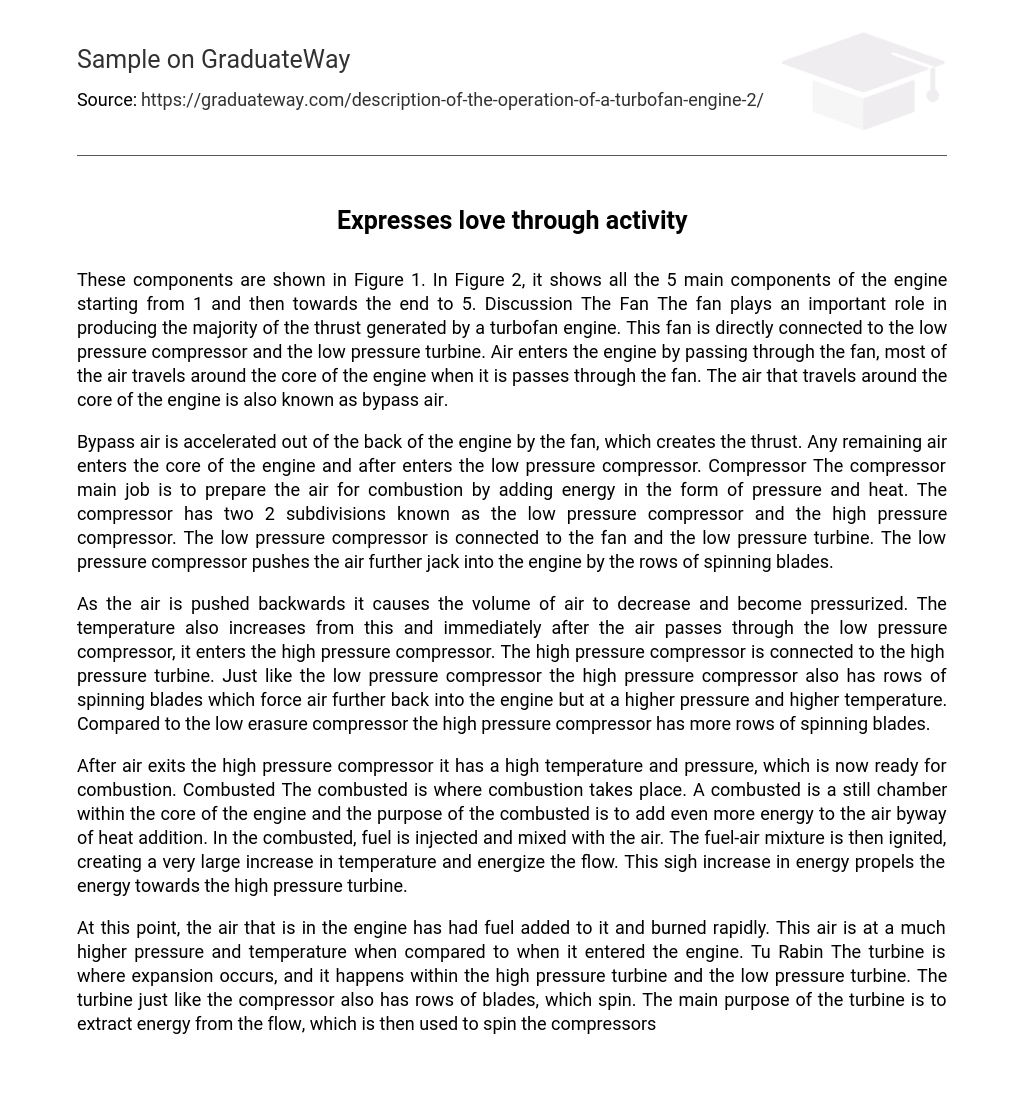These components are shown in Figure 1. In Figure 2, it shows all the 5 main components of the engine starting from 1 and then towards the end to 5. Discussion The Fan The fan plays an important role in producing the majority of the thrust generated by a turbofan engine. This fan is directly connected to the low pressure compressor and the low pressure turbine. Air enters the engine by passing through the fan, most of the air travels around the core of the engine when it is passes through the fan. The air that travels around the core of the engine is also known as bypass air.
Bypass air is accelerated out of the back of the engine by the fan, which creates the thrust. Any remaining air enters the core of the engine and after enters the low pressure compressor. Compressor The compressor main job is to prepare the air for combustion by adding energy in the form of pressure and heat. The compressor has two 2 subdivisions known as the low pressure compressor and the high pressure compressor. The low pressure compressor is connected to the fan and the low pressure turbine. The low pressure compressor pushes the air further jack into the engine by the rows of spinning blades.
As the air is pushed backwards it causes the volume of air to decrease and become pressurized. The temperature also increases from this and immediately after the air passes through the low pressure compressor, it enters the high pressure compressor. The high pressure compressor is connected to the high pressure turbine. Just like the low pressure compressor the high pressure compressor also has rows of spinning blades which force air further back into the engine but at a higher pressure and higher temperature. Compared to the low erasure compressor the high pressure compressor has more rows of spinning blades.
After air exits the high pressure compressor it has a high temperature and pressure, which is now ready for combustion. Combusted The combusted is where combustion takes place. A combusted is a still chamber within the core of the engine and the purpose of the combusted is to add even more energy to the air byway of heat addition. In the combusted, fuel is injected and mixed with the air. The fuel-air mixture is then ignited, creating a very large increase in temperature and energize the flow. This sigh increase in energy propels the energy towards the high pressure turbine.
At this point, the air that is in the engine has had fuel added to it and burned rapidly. This air is at a much higher pressure and temperature when compared to when it entered the engine. Tu Rabin The turbine is where expansion occurs, and it happens within the high pressure turbine and the low pressure turbine. The turbine just like the compressor also has rows of blades, which spin. The main purpose of the turbine is to extract energy from the flow, which is then used to spin the compressors and the fan. Continuous thrust is generated when the spinning fan draws more air through the core of the engine.
The high pressure turbine is driven by the high pressure air that passes through it. The high pressure turbines area is initially small but it increases as it goes through. This change in area allows the air to expand, increasing in volume which decreases the pressure and temperature. The decrease in pressure and temperature correspond to a decrease in the overall energy in the airflow. Air that exits the high pressure turbine is cooler and less pressurized than the air entering. But his air is still useful and is extracted by the low pressure turbine.
The low pressure turbine functions just like the high pressure turbine. But it is connected to the low pressure compressor and the fan. When the low pressure turbine is driven by air, it also drives the low pressure compressor and the fan. When the low pressure compressor spins it provides the high pressure compressor with air to feed the combusted. The fan then spins and it provides the low pressure compressor with air to feed the high pressure compressor, and this produces thrust. Air that exits the low pressure turbine immediately enters the exhaust nozzle.
Exhaust Nozzle The exhaust nozzle is the last component that the airflow touches before exiting the engine. The purpose of the exhaust nozzle is to propel the core flow out of the engine, which provides thrust. The exhaust nozzle also helps regulate pressures within the engine, which keeps other components functioning properly. Conclusion The operation of a turbofan engine involves six steps. First, air enters the engine through the fan, which is driven by the low pressure turbine. Then most of the air is accelerated out of the back of the engine, creating thrust.
After that a portion of air travels through the low pressure and high pressure compressors. Then this air is compressed and then mixed with fuel, igniting it, which adds heat energy in the combusted. The heat energy and pressure energy cause the air to expand through the turbines, spinning both the high and low pressure turbines which eventually spin the fan and compressors. Finally, air exits the turbines and exits the engine through the exhaust nozzle, which generates even more thrust to propel the vehicle forward or backwards. At this point the cycle is complete, and the process repeats.





